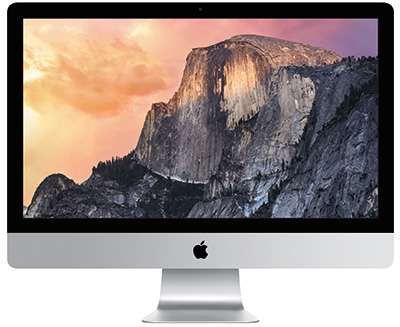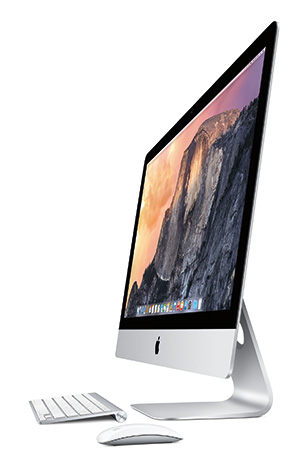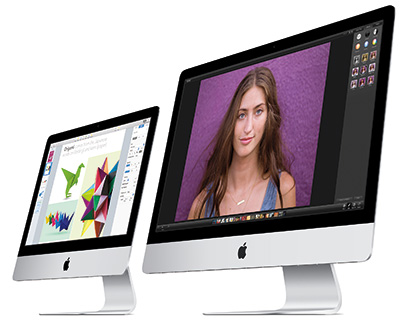
Though masquerading as a humble 27-inch iMac, Apple unleashed a monster this week: a new 5K iMac. Named the “iMac with Retina 5K Display,” it delivers 67% more pixels than a 4K display: 5,120 pixels across and 2,880 pixels high; 14.7 million pixels! (14,745,600 to be exact).
Here’s the highlights of the new unit:
A recent blog post on iFixIt indicates that, aside from the display, the new iMac uses the same components as existing 27″ iMacs. (Read it here.)
This is the iMac page on Apple’s website: http://www.apple.com/imac/
NOTE: The starting price is $2,499, which provides a very nice system. Configured for maximum productivity, the price is a still-reasonable $3,599.
THINGS TO THINK ABOUT

From an engineering point of view, this is an amazing monitor at a very attractive price; especially when I can remember HD video monitors costing upwards of $20,000.
There are two cautions to this system, though, that you need to consider:
According to Apple’s press release: “Every iMac with Retina 5K display is calibrated using three state-of-the-art spectro-radiometers to ensure precise and accurate color.”
What I don’t know as I write this is which color space these calibrators are using and whether we can trust the colors on the screen for critical video work. For web video and, most likely, photography, I’m sure this monitor represents most colors well. However, for more critical video work, I need to learn more about how this is calibrated.
Remember that new-and-improved Timing Controller mentioned above? This puppy needs to pump out a LOT of data to feed full-frame, high-frame-rate video to 14.7 million pixels. In fact, it requires so much bandwidth that the current DisplayPort 1.2 standard can’t support it. This is why there’s no separate 5K display – we don’t have any connection on the Mac that’s fast enough to get the data from the computer to the monitor. As fast as Thunderbolt 2 is, it is too slow to support monitors this big.
I expect that to change with upcoming standards such as DisplayPort 1.3 and Thunderbolt 3. However, for now, 5K is limited to just this system.
NOTE: It is interesting to me that the pixel dimensions of this monitor exactly match the supported pixel dimensions of DisplayPort 1.3 (See this AnandTech article.) This is an image size we will be hearing more about in the future. (The iMac screen dimensions also exactly double the screen dimensions of the non-Retina 27″ iMac: 2560 x 1440.)

A NOTE ON TEXT
It is a fact of physics that if monitor size remains the same while pixel density (resolution) increases, then the size of each pixel must get smaller. As pixels get smaller, the text displayed by the application should also get smaller.
But, here, Apple is doing something clever. On the new iMac with 5K Retina display, if you run the system at “Best for Retina” resolution in System Preferences > Display, the physical size of onscreen objects (for example, text and buttons) is the same as the non-Retina 27″ display. This is because Apple has created an invisible “grid” that overlays the on-screen pixels, not just for this computer, but as part of their overall OS development system.
Developers create their user interface using coordinates on this grid. This means that text sizes don’t change, even though pixel density does. This keeps interface elements looking consistent, while the increased pixel density of the 5K iMac makes everything look sharper and higher resolution.
NOTE: For comparison, this behavior is similar to the 15″ MacBook Pro with Retina display as compared to the previous generation 15″ MacBook Pro without Retina display.
CONFIGURATION THOUGHTS
If you don’t need the extra pixels, stay with the existing 27″ iMac. The only reason to step up to this system is for the extra screen resolution.
The entry system is very nice for people that need more pixels but don’t need to move them around very quickly. Still photographers come first to mind.
As your budget allows, I would recommend the following options, listed in priority with the highest on top:
Personally, I like the 1 TB Fusion drive a lot because it does a nice job of balancing performance and storage space with cost; so I don’t generally recommend upgrading to other options. I have it installed on two of my new iMacs and find its performance excellent. Its integral SSD drive gives me speed for repetitive tasks and the 1 TB hard drive means that I have internal storage as well.
NOTE: A Fusion drive combines both SSD and standard spinning media into a single unit. The SSD is 128 GB in size and is programmed to store the portions of the OS, applications and data that you use the most. This accelerates your most common tasks, while still providing lots of extra internal storage if you need it.
Keep in mind that for all media work, I ALWAYS recommend storing projects and media on a second drive – ideally, a RAID 5 system, if your budget permits. I only use the internal drive for the operating system, applications and temporary files.
Excluding the cost of RAM, which varies by vendor, the new configured price of the iMac is $2999.00, excluding AppleCare and tax. This is still an amazing price.
SUMMARY
I really like the current crop of iMacs and, from what I read, the 5K iMac fits very well into that family. However, my strong recommendation is to see one of these in person at an Apple Store, run the applications on it that you commonly use, and see how it looks.
Whether this is a good system for you depends upon what you are doing:
It is always nice to have choices.
2,000 Video Training Titles
Edit smarter with Larry Jordan. Available in our store.
Access over 2,000 on-demand video editing courses. Become a member of our Video Training Library today!
Subscribe to Larry's FREE weekly newsletter and
save 10%
on your first purchase.
22 Responses to Apple Releases New 5K iMac
Newer Comments →-
 Mark Dobson says:
Mark Dobson says:
October 20, 2014 at 5:48 am
-
 LarryJ says:
LarryJ says:
October 20, 2014 at 7:24 am
-
 James Gleason says:
James Gleason says:
October 20, 2014 at 5:52 am
-
 LarryJ says:
LarryJ says:
October 20, 2014 at 7:24 am
-
 James Gleason says:
James Gleason says:
October 20, 2014 at 9:49 am
-
 Jim B says:
Jim B says:
October 20, 2014 at 5:52 am
-
 LarryJ says:
LarryJ says:
October 20, 2014 at 7:25 am
-
 Mark Dobson says:
Mark Dobson says:
October 20, 2014 at 6:06 am
-
 LarryJ says:
LarryJ says:
October 20, 2014 at 7:27 am
-
 Mark Dobson says:
Mark Dobson says:
October 20, 2014 at 7:43 am
-
 George Knochel says:
George Knochel says:
October 20, 2014 at 7:51 am
-
 LarryJ says:
LarryJ says:
October 20, 2014 at 5:42 pm
-
 Seth Mellman says:
Seth Mellman says:
October 20, 2014 at 8:31 am
-
 LarryJ says:
LarryJ says:
October 20, 2014 at 5:44 pm
-
 gloria messer says:
gloria messer says:
October 20, 2014 at 10:08 am
-
 Yves says:
Yves says:
October 23, 2014 at 11:17 pm
-
 Larry Jordan says:
Larry Jordan says:
October 24, 2014 at 6:41 am
-
 Gary Gamache says:
Gary Gamache says:
October 24, 2014 at 1:42 pm
-
 LarryJ says:
LarryJ says:
October 24, 2014 at 7:24 pm
-
 Kent says:
Kent says:
December 9, 2015 at 8:15 am
-
 Larry says:
Larry says:
December 9, 2015 at 11:31 am
Newer Comments →Hi Larry,
Thanks for the review. You mention that the iMac 5k only supports one monitor and that got me a bit concerned so I checked with Apple and as with my current iMac 27″ you can connect a second monitor – and that could be a 4k monitor.
I think you probably meant that you can’t have 3 monitors?
Anyway another timely post from you
many thanks
Mark
Mark:
You are correct and my wording was bad, which I’ve now corrected.
What I should have written was that this computer can not be used as a second, external monitor due to bandwidth limitations.
Larry
Thanks Larry for the first look. I’ve been saving my pennies for a Rev. B nMP, but those seem far out on the horizon. Do you think you will be able to test the 5K iMac with FCPX? That’s the kicker for me. I want to see how it compares to the nMP (6-core/D500). I do hobby FCPX work and now shoot 4K with my GH4. It would be nice to save money over the nMP if I’m not giving up much.
James:
I’m not planning to do a comparison test in the near future between the two. However, in general, FCP X will work fine on both – the gating factor is not the computer, but the speed of your storage.
Larry
No problem. Currently I am working of a 2008 Mac Pro 2.8 8-core with ATI 5870 video card. I’m sure this will be the update I’ve been waiting for! Now, off to the Apple store to check it out in person. Thanks for all you do.
I’m a little confused by your statement under cautions “Only supports one monitor”.
On the Apple store site under Tech Specs for the system, two items are specified that seem to contradict your statement:
Under Video Support and Camera:
“Simultaneously supports full native resolution on the built-in display and up to 3840 by 2160 pixels on an external display
Support for extended desktop and video mirroring modes”
Under Connections and Expansion:
“Mini DisplayPort output with support for DVI, VGA, and dual-link DVI (adapters sold separately)”
Can you clarify, please? Did you perhaps mean “Only supports one external monitor”?
Jim:
You are not the only one confused – it was my bad writing.
What I meant to say was that this computer could not be used as an second, external monitor. It still supports the usual complement of external monitors as do all other iMacs.
Sorry,
Larry
Just one more thing Larry
The iMac 5K has Thunderbolt 2 – will this speed up data flow for editing with my Thunderbolt 2 OWC Thunder raid? Do you think I’ll see any benefit from the fact that its Thunderbolt 2?
Because if I’m not going to see a huge improvement in performance the other option is too simply buy 4K monitor and stick that on my current maxed out 27″ iMac.
Mark:
No. The speed of the OWC is determined by the number of drives it contains, not the protocol. The four drive system, which I like a lot, even when loaded with SSD drives, does not exceed Thunderbolt 1 speeds. Thunderbolt 2 is provided for compatibility reasons, not speed.
Larry
Ok Larry – thanks for that information.
I guess I’ll check out the new iMac in the apple store and see how much better the screen is because from what you say and I can work out I’m only going to get a marginal increase in performance from the new processor and graphics card.
Thanks Larry for your always excellent thoughts and analysis. One thing I want to elaborate on is when you said “The only reason to step up to this system is for the extra screen resolution.” —
I must point out that even though I have a 2011 iMac i5, and don’t currently use 4K video yet, I’m going to step up to this system for my video and photography work because it is certainly a step up for anyone with an iMac:
1) The Retina iMac’s 4 GHz option is the new Quad Core i7-4790K, which is now the fastest CPU in the world for most single-threaded tasks, and outperforms and/or keeps up with such systems as the new Mac Pro with 4 and 6 cores.
2) The AMD M295X graphics card is outstanding and better than what is in any iMac before..
3) Thunderbolt 2 has much faster capabilities (if you have a RAID setup to take advantage of the speed).
I refer everyone to a Marco.org article on why he’s moving from his new Mac Pro to this new iMac Retina system, at http://www.marco.org/2014/10/16/retina-imac-vs-mac-pro).
George:
All good comments and Marco’s article was excellent.
Thanks for sharing.
Larry
Thanks Larry for keeping us so well up-to-date on all things Mac and FCPX. I have been getting by on my late model 2008 Mac Pro for work in my small corporate video business. I mostly shoot single camera HD with an occasional 2 or 3 camera shoot. No plans to go to 4K anytime soon as my clients have no idea what it is. I was waiting for details on the new iMac release and am finally ready to update my computer. For me it looks like there is about a $500 difference between the older iMac 27″ and the new Retina model (these would both include the better processors and graphics cards). To me this cost increase seems worth the bump in performance, but would love your thoughts. Thanks for your time.
Seth:
I would agree – if you are going from a 2008 Mac Pro, the new 5K iMac will be faster, quieter, and “better.” Invest in faster CPU and GPU options.
I personally like the Fusion drive, but for pure speed, SSD will be faster. Otherwise, the configurations I illustrate in this article still seem good to me.
Larry
Thanks Larry
Great Article.
Am getting ready for upgrade and looking forward to your further comments.
xxo glo
Hi there,
Thanks for the review, I’m finally ready to upgrade and this machine seems like a great investment. My question is how it will handle scaling up HD content, as that vast majority of my work is still 1080p, and will be for the next while. This machine has great future-proofing which is nice, but I’m worried how it will handle my current workflow. With all that resolution, I’m affaid that when I want to look at my edit any bigger than what it would be at native res that it would come out pixilated/soft. I can work for a while with a smaller image, but when it comes to reviewing my edit, I love to look at the image full-screen and with HD content I just don’t know what would happen on this display. Thanks.
Yves:
My guess is that the video won’t look any worse on this monitor than on a standard 27″ iMac, which also exceeds the resolution of 1080p HD video.
However, the best thing to do is copy a clip to a thumb drive and bring it into an Apple store and play it on the monitor and see what you think.
Larry
Can the 5K retina display be calibrated using monitor calibration software?
Gary:
I would expect this iMac to be no different than any other iMac regarding calibration.
Larry
Larry;
What do you recommend as a procedure for color calibration of the 5k iMac?
Thanks
Kent
Kent:
Generally, I’d leave it at the defaults, or calibrate it using the tools in System Preferences > Display. (This doesn’t have a Rec. 709 setting, so, I’d use sRGB in its place.)
Larry